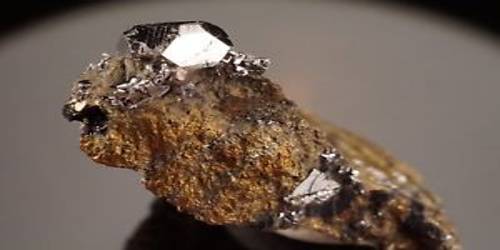Nontronite is an iron(III)-rich clay mineral in the smectite group. It is a pale yellow or greenish clay mineral composed primarily of hydrous iron silicate and is classified as montmorillonite with iron replacing some or all of the aluminum. Nontronites typically have a chemical composition that is greater than 30% Fe2O3 and less than 12% Al2O3 (ignited basis). Pierre Berthier named it in 1827 after the type locality, which is thought to be Nontron, Dordogne, France.
Nontronite, like montmorillonite, has very few economic deposits. Nontronite, like montmorillonite, can have varying amounts of adsorbed water associated with the interlayer surfaces and exchange cations.
Ca.5(Si7Al.8Fe.2)(Fe3.5Al.4Mg.1)O20(OH)4 is a typical structural formula for nontronite. Nontronite’s dioctahedral sheet is primarily composed of trivalent iron (Fe3+) cations, with some substitution by trivalent aluminum (Al3+) and divalent magnesium (Mg2+).
The tetrahedral sheet is primarily composed of silicon (Si4+), but it can have significant (about 1 in 8) substitution of either Fe3+ or Al3+, or combinations of these two cations. Thus, nontronite is distinguished by the presence of the majority (usually greater than 60%) of the layer charge in the tetrahedral sheet. Divalent calcium (Ca2+) or magnesium (Mg2+) are commonly used to balance the layer charge.
General Information
- Category: Phyllosilicates (Smectite group)
- Formula: (repeating unit) Ca.5(Si7Al.8Fe.2)(Fe3.5Al.4Mg.1)O20(OH)4
- Crystal system: Monoclinic
- Color: Yellow, olive-green, green, orange, brown

Properties
Weathering of biotite and basalts, precipitation of iron and silicon-rich hydrothermal fluids, and deep-sea hydrothermal vents all produce nontronite. Microorganisms may play an important role in their formation, according to some evidence. When soils undergo anoxia, microorganisms are also involved in the reduction of structural iron in nontronite, and the reduced form of the clay appears to be highly reactive towards certain pollutants, possibly contributing to the destruction of these compounds in the environment.
- Crystal habit: Earthy masses
- Cleavage: Perfect basal
- Mohs scale hardness: 1.5 to 2
- Luster: Earthy to dull
- Streak: Colorless
- Specific gravity: 2.3
- Optical properties: Biaxial (-)
Occurrences
The only known commercially viable and operational nontronite mine is located in Canterbury, New Zealand. The mine is operated by Palmer Resources and the finished products are used internationally in industrial applications (pulp & paper, surface coating) and in cosmetics marketed as New Zealand Glacial Clay.
Information Source:
















